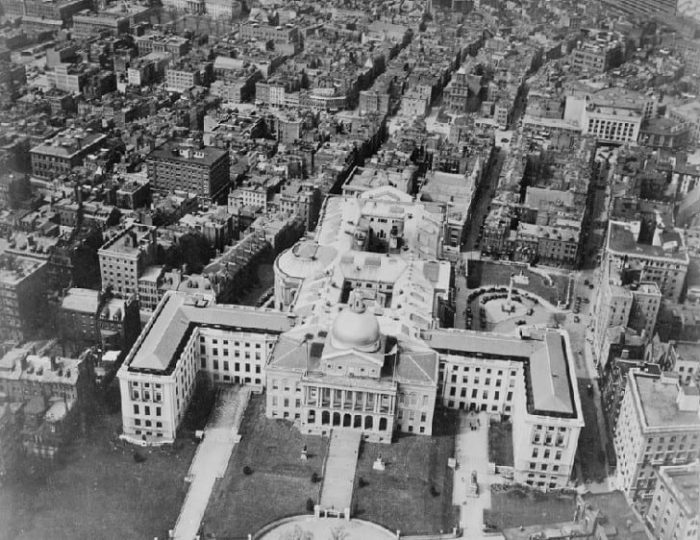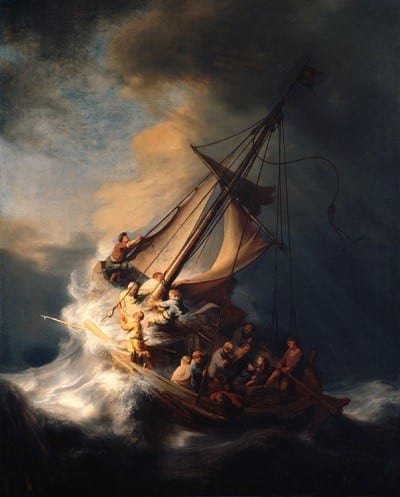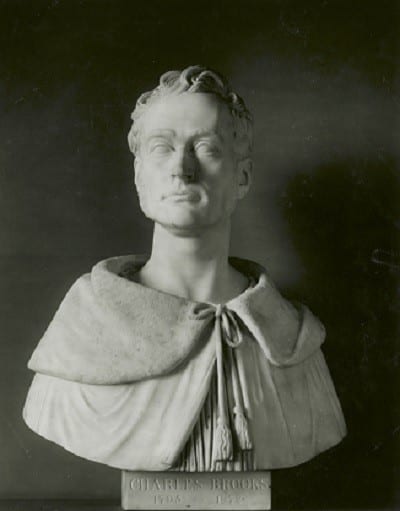
Column first published on March 23, 2015 under the title “LA OR BUST”
I wrote this column last time the general public was obsessed with the Gardner heist. With the new Netflix documentary that rehashes that old tale for the zillionth time without adding anything new generating yet another round of interest in the topic, I decided to beat my old drum about all of the art that has gone missing in Boston that nobody cares about. Please read on. We can get some of it back! -CF
In uttering their first words, it’s common for babies in Greater Boston to feign knowledge of where Isabella Stewart Gardner’s missing masterpieces are stashed. For transient aesthetes and crime junkies, the fascination with the most notorious museum jack in US history comes later in life, typically while reading any number of accounts by the thrill seekers and writers who long ago drowned in promises that someone would return Rembrandt’s “Storm on the Sea of Galilee.”
I’m among those who have obsessed over the Gardner loss. Five years ago I devoured nearly a dozen books about those relics and other marquee thefts, and even embarked on my own mission to recover stolen art. Instead of celebrated works by Flinck and Vermeer however, I set my eyes on more attainable prizes: namely, any of the several hundred items pilfered right out of the Massachusetts State House over the last 200-plus years.
 Some background: As one might expect considering the commonwealth’s robust history, our State House has been blessed by more bequeathments than most capital buildings. At the same time, Massachusetts has from day one lagged in the art maintenance department, with the first office to oversee valuable works not opening its doors until 1910. One could steal on Beacon Hill with legendary ease; in 1956, two reporters from the Boston Herald Traveler, in order to highlight security shortcomings, lifted more than $20,000 worth of archived documents without getting caught, and splashed pictures of their gotcha grab across page one.
Some background: As one might expect considering the commonwealth’s robust history, our State House has been blessed by more bequeathments than most capital buildings. At the same time, Massachusetts has from day one lagged in the art maintenance department, with the first office to oversee valuable works not opening its doors until 1910. One could steal on Beacon Hill with legendary ease; in 1956, two reporters from the Boston Herald Traveler, in order to highlight security shortcomings, lifted more than $20,000 worth of archived documents without getting caught, and splashed pictures of their gotcha grab across page one.
All of which makes the whole of these discoveries, at least in my opinion, worthy of at least a fraction of the mass attention paid to the Gardner for the silver anniversary of its shadow this past week. Possibly the most peculiar and slowest purloining of all time, what happened to the State House is a heist of several centuries. As I learned through months of cross-referencing old manifests with works that remain in the Beacon Hill collection, the lengthy list of items looted from the commonwealth includes: murals of John Adams and of Golden Dome architect Charles Bulfinch, assorted ephemera including Native American arrowheads, more than 400 documents from the Colonial Era, and a 1900-square-foot stained glass ceiling that was described by the Associated Press as “one of the largest single skylights in the country” before it was removed from the House chamber in 1970 and presumably parsed among reps who hoarded the pieces as mementos. The list goes on; in 1984, page one of the 1629 Massachusetts Bay Company Charter was even stolen from the State House basement along with the wax seal that King Charles I stamped on the document.
Though investigators never found out who specifically nabbed the charter, the list of likely doers included some of the same suspected characters linked to the Gardner ordeal six years later. In any case, the 17th-century document showed up during a drug raid in Dorchester within months, while the seal was found more than a decade later in an unrelated Randolph sting. Amateur larceny probably accounts for most of what has vanished from the State House, keepsakes nonchalantly pocketed by lawmakers and legislative aides with sticky fingers; a select few robberies however, resemble more the work of professional crooks, the likes of whom may have also swiped the bust of early public education advocate Charles Brooks. It’s not as thrilling a story as the Gardner gank, but I seem to have traced the sculpture of Brooks, an ally of Horace Mann who helped modernize American pedagogy, from Beacon Hill to the Los Angeles County Museum of Art (LACMA), where it’s currently in storage. Considering how excited people have been about recently unearthed time capsules, maybe someone with authority might even follow up …
The story starts in 1835, when prodigious artist Thomas Crawford moved from New York City to Rome, where he was among the first American sculptors of significant renown. According to documents I found in the Houghton Library for rare books and manuscripts at Harvard University, Crawford was commissioned for the bust in the early 1840s, around the time he started work on “Orpheus and Cerberus,” a marble version of which is housed at the Museum of Fine Arts, Boston. As per my earlier reporting:
-
Crawford’s career was helped greatly by Massachusetts Senator Charles Sumner and George Washington Greene, who was the American consul in Rome at the time. It was presumably through them that Crawford met Brooks, who apparently first requested a bust of himself in 1842. Crawford quoted Brooks $250—his “established price”—and it appears that he was paid $100 up front with the remainder coming years later.
-
Crawford wrote his subject several letters in the 1840s. Though the bust has in the past been catalogued under the date 1842, correspondence shows that while Brooks and Crawford started negotiating the cost in that year, the artist continued working on the sculpture into 1843. “I am at present completing your bust—and hope to have it ready for a ship that is expected at [the Italian port city] Leghorn arriving next month,” Crawford wrote on May 19, 1843.
-
The amount due after the deposit, according to the correspondence, was $178—most likely $150 for the marble bust, and an additional $28 for a form cast that could be used to make duplicates. According to a July 18, 1843, letter from Crawford, Brooks had also requested four plaster facsimiles to be molded and shipped with the original marble sculpture. In that same note, Crawford apologized for his tardiness: “An unexpected delay has occurred, in consequence of the caster not having been able to [indecipherable] when he had promised for the purpose of making the mold. I did hope and so expressed myself an answer to your letter from Paris that the bust might leave Rome with the statue of Orpheus and other works which were ready at the time . . . It was only a week since that the caster could apply himself to make the mold and he is now casting the four copies you desire. They will require several days to dry well before it will be possible to pack them and then all will be ready for the departure.”
 Though there does exist an 1845 receipt sent by Crawford to Brooks for a total that would have included the copies, I am unable to find evidence that any of the duplicates ever arrived in America. The Brooks bust in storage at the LACMA is marble, so what’s important is which artifact was at the State House—the original that’s in Los Angeles, or a knockoff made of plaster. Leads are inconclusive. A 1907 biography of Brooks vaguely notes that a bust given by his estate was “placed appropriately in the office of the State Board of Education, Massachusetts State House.” Similarly, a 1924 State House Guide Book merely acknowledges that the gift was received by the commonwealth in 1892, “conforming to the wishes of his family.”
Though there does exist an 1845 receipt sent by Crawford to Brooks for a total that would have included the copies, I am unable to find evidence that any of the duplicates ever arrived in America. The Brooks bust in storage at the LACMA is marble, so what’s important is which artifact was at the State House—the original that’s in Los Angeles, or a knockoff made of plaster. Leads are inconclusive. A 1907 biography of Brooks vaguely notes that a bust given by his estate was “placed appropriately in the office of the State Board of Education, Massachusetts State House.” Similarly, a 1924 State House Guide Book merely acknowledges that the gift was received by the commonwealth in 1892, “conforming to the wishes of his family.”
As my research also showed, besides there being no trace of plaster Brooks busts anywhere, the best proof that the sculpture in Los Angeles came from the State House seems to be an auction record dating back to 1992. Though the identities of the seller and buyer are private, a marble bust of Brooks—perfectly resembling the item in question—was auctioned off by the Hub-based Grogan & Company for $6,000 on December 9, 1992. The following year, a marble bust of Brooks was donated to the LACMA by a Mr. and Mrs. Herbert M. Gelfand. I compared an image of the work from LACMA’s catalogue to a photo from the 1920s that was snapped at the State House, and they appear to be identical—both with distinct marble characteristics right down to a signature spot on the base beside the subject’s birth year.
In 2012, a spokesperson for the commonwealth said the bust missing from Boston is not the sculpture I found in Los Angeles. Off the record, a source from former Governor Deval Patrick’s office told me the administration felt my article drew unnecessary negative attention. Meanwhile, a contact at LACMA promised the museum would check relevant documentation, but then stopped returning my calls and emails. I’m done playing phone tag, but as far as I am aware, nobody has proven me wrong.
I’m not attempting to open old wounds or to shame anyone; the small office that handles state art has been historically starved, and has made substantial progress in restoring tattered old works despite the lack of preservation funding. Furthermore, I’ll happily retract my claims about the bust if somebody who digs deeper than I have offers compelling proof. My goal here is just to convince Governor Charlie Baker to retrieve Charlie Brooks, and to help secure a recovery for a region and an art community in desperate need of a historic homecoming.
A Queens, NY native who came to New England in 2004 to earn his MA in journalism at Boston University, Chris Faraone is the editor and co-publisher of DigBoston and a co-founder of the Boston Institute for Nonprofit Journalism. He has published several books including 99 Nights with the 99 Percent, and has written liner notes for hip-hop gods including Cypress Hill, Pete Rock, Nas, and various members of the Wu-Tang Clan.



